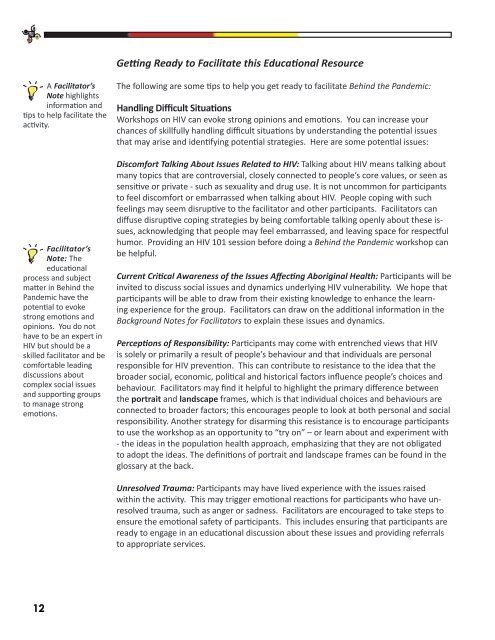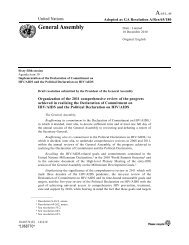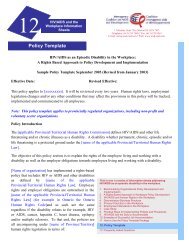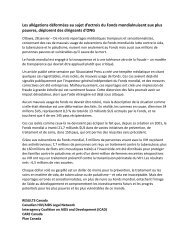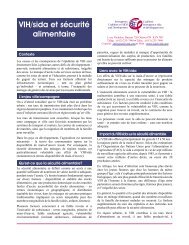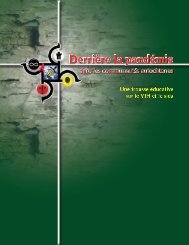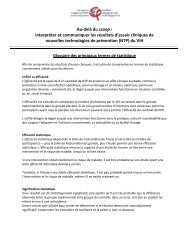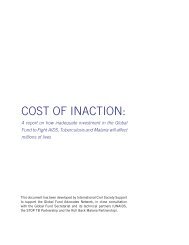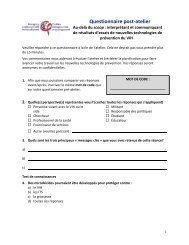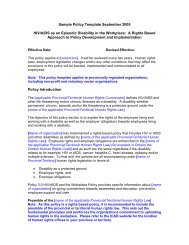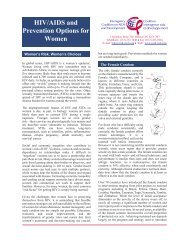Behind the Pandemic in Aboriginal Communities - Interagency ...
Behind the Pandemic in Aboriginal Communities - Interagency ...
Behind the Pandemic in Aboriginal Communities - Interagency ...
- No tags were found...
You also want an ePaper? Increase the reach of your titles
YUMPU automatically turns print PDFs into web optimized ePapers that Google loves.
Gett<strong>in</strong>g Ready to Facilitate this Educational ResourceA Facilitator’sNote highlights<strong>in</strong>formation andtips to help facilitate <strong>the</strong>activity.Facilitator’sNote: Theeducationalprocess and subjectmatter <strong>in</strong> <strong>Beh<strong>in</strong>d</strong> <strong>the</strong><strong>Pandemic</strong> have <strong>the</strong>potential to evokestrong emotions andop<strong>in</strong>ions. You do nothave to be an expert <strong>in</strong>HIV but should be askilled facilitator and becomfortable lead<strong>in</strong>gdiscussions aboutcomplex social issuesand support<strong>in</strong>g groupsto manage strongemotions.The follow<strong>in</strong>g are some tips to help you get ready to facilitate <strong>Beh<strong>in</strong>d</strong> <strong>the</strong> <strong>Pandemic</strong>:Handl<strong>in</strong>g Difficult SituationsWorkshops on HIV can evoke strong op<strong>in</strong>ions and emotions. You can <strong>in</strong>crease yourchances of skillfully handl<strong>in</strong>g difficult situations by understand<strong>in</strong>g <strong>the</strong> potential issuesthat may arise and identify<strong>in</strong>g potential strategies. Here are some potential issues:Discomfort Talk<strong>in</strong>g About Issues Related to HIV: Talk<strong>in</strong>g about HIV means talk<strong>in</strong>g aboutmany topics that are controversial, closely connected to people’s core values, or seen assensitive or private - such as sexuality and drug use. It is not uncommon for participantsto feel discomfort or embarrassed when talk<strong>in</strong>g about HIV. People cop<strong>in</strong>g with suchfeel<strong>in</strong>gs may seem disruptive to <strong>the</strong> facilitator and o<strong>the</strong>r participants. Facilitators candiffuse disruptive cop<strong>in</strong>g strategies by be<strong>in</strong>g comfortable talk<strong>in</strong>g openly about <strong>the</strong>se issues,acknowledg<strong>in</strong>g that people may feel embarrassed, and leav<strong>in</strong>g space for respectfulhumor. Provid<strong>in</strong>g an HIV 101 session before do<strong>in</strong>g a <strong>Beh<strong>in</strong>d</strong> <strong>the</strong> <strong>Pandemic</strong> workshop canbe helpful.Current Critical Awareness of <strong>the</strong> Issues Affect<strong>in</strong>g Aborig<strong>in</strong>al Health: Participants will be<strong>in</strong>vited to discuss social issues and dynamics underly<strong>in</strong>g HIV vulnerability. We hope thatparticipants will be able to draw from <strong>the</strong>ir exist<strong>in</strong>g knowledge to enhance <strong>the</strong> learn<strong>in</strong>gexperience for <strong>the</strong> group. Facilitators can draw on <strong>the</strong> additional <strong>in</strong>formation <strong>in</strong> <strong>the</strong>Background Notes for Facilitators to expla<strong>in</strong> <strong>the</strong>se issues and dynamics.Perceptions of Responsibility: Participants may come with entrenched views that HIVis solely or primarily a result of people’s behaviour and that <strong>in</strong>dividuals are personalresponsible for HIV prevention. This can contribute to resistance to <strong>the</strong> idea that <strong>the</strong>broader social, economic, political and historical factors <strong>in</strong>fluence people’s choices andbehaviour. Facilitators may f<strong>in</strong>d it helpful to highlight <strong>the</strong> primary difference between<strong>the</strong> portrait and landscape frames, which is that <strong>in</strong>dividual choices and behaviours areconnected to broader factors; this encourages people to look at both personal and socialresponsibility. Ano<strong>the</strong>r strategy for disarm<strong>in</strong>g this resistance is to encourage participantsto use <strong>the</strong> workshop as an opportunity to “try on” – or learn about and experiment with- <strong>the</strong> ideas <strong>in</strong> <strong>the</strong> population health approach, emphasiz<strong>in</strong>g that <strong>the</strong>y are not obligatedto adopt <strong>the</strong> ideas. The def<strong>in</strong>itions of portrait and landscape frames can be found <strong>in</strong> <strong>the</strong>glossary at <strong>the</strong> back.Unresolved Trauma: Participants may have lived experience with <strong>the</strong> issues raisedwith<strong>in</strong> <strong>the</strong> activity. This may trigger emotional reactions for participants who have unresolvedtrauma, such as anger or sadness. Facilitators are encouraged to take steps toensure <strong>the</strong> emotional safety of participants. This <strong>in</strong>cludes ensur<strong>in</strong>g that participants areready to engage <strong>in</strong> an educational discussion about <strong>the</strong>se issues and provid<strong>in</strong>g referralsto appropriate services.12


